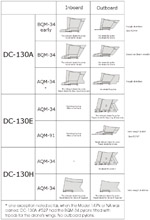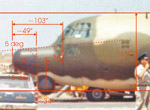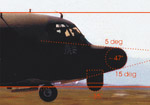

A total of sixteen C-130 Hercules aircraft were modified to carry drones for the US Military over a period of some fifteen years. Their service may be organized as follows:
The first two: 57-0496 and 497 which appear to have been modified off of the Lockheed production line and assigned to the Air Force Missile Development Center at Holloman Air Force Base NM and were initially used for Q-4B development. They also flew Lightning Bug flight tests, launched the first Model 147B reconnaissance missions over China and flew many 147 development missions at Pt. Mugu for the Air Force. Eventually, they were transferred to the Navy
Vietnam operations: drone operations over China and Vietnam could not be sustained by just the two drone carriers. Three C-130As (56-0527, 56-0514 and 57-0461) and three C-130Es (61-2368, 61-2369 and 61-2371) were converted in the 1965-6 timeframe. It is possible that the DC-130As were intended for tactical drone operations and the more powerful and longer ranged DC-130Es were intended for strategic operations with 'big winged' Model 147s over China. The DC-130As generally migrated to test activities after the war and the DC-130Es, after serving with the 432nd TDG, rejoined the transport fleet as C-130Es
Compass Arrow: three Hercules were converted to DC-130E (61-2361, 61-2362 and 61-2363) in 1967 and 68 and assigned to the AFMDC for the Ryan Model 154 Compass Arrow development effort at Holloman AFB. After that program ended, they went to the 432nd TDG at Davis-Monthan AFB. When the Force shut down combat drone operations in 1979, these were returned to C-130E configuration and rejoined the transport fleet
The Navy conversions: C-130As 55-0021 (BuNo 158228) and 56-0491 (BuNo 158829) which were converted in 1969 for Navy use in target launching after the retirement of the Navy's DP-2E Neptunes. These two aircraft were quickly retired when surplus Air Force DC-130As became available in 1979. These were unique in that they did not carry the standard DC-130 'Pinocchio' radome
Further development and attrition reserve: one additional C-130E (61-2364) and one C-130A (57-0523) were converted in the early 1970s to add to the fleet. Additionally, one HC-130H (65-0979) was converted
Some confusion reigns about DC-130H 65-0971. It was built as an HC-130H, and designated in the 1978 timeframe as a DC-130H, but it appears it was not physically configured as a DC-130H. It was later converted to an MC-130P
(Text kindly contributed by Craig Kaston)
The following externally visible features make a DC-130 (information courtesy of Paul Dion):
Two or four pylons for Firebees and other drones. See below for further discussion
An extended radome ('Pinocchio' nose), possibly from a Lockheed Constellation? The extended radome was not installed on the two DC-130s converted by the Navy (158228/9)
A 'thimble' radome was added later, below the main radome. It was later removed from the ex-Air Force DC-130s operated by the Navy (496, 497, 514 and 461). The radome was possibly part of the Microwave Command Guidance System used on many AQM-34 versions that had a small blade antenna on the tail fin tip
Square KC-130 windows were fitted in the paratroop doors, for the drone launchers to watch things, especially the elevator position rods on the drone endplates
All C-130As were built with three bladed Curtiss Electric props, later retrofitted with four bladed Hamilton Standard props
The DC-130Es had lights installed in the external fuel tank pylons facing outboard
The pylons showed some variations over the years. Some comments:
496 and 497 were possibly the only USAF DC-130s with four pylons up to at least 1973. 514 had four pylons when photographed in 1978
The DC-130Es only had outboard drone pylons. The single DC-130H could be fitted with four drone pylons
The inboard pylon changed somewhat during the 45 years use of the DC-130. The main change was an aft extension of the lower half, giving a V-shaped trailing edge. Likely this extension was made so an electrical umbilical (plugging into the electronics bay aft of the fuselage extension) was protected. The modified pylons had aft facing lights in the upper trailing edge. The inboard pylons were always braced with two streamline struts
The outboard pylon was changed considerably over the years. Initially DC-130As had a straight leading edge with a small boom projecting forward. Later a forward extension was added to the lower end, generally similar to the inboard pylon. On the DC-130E the forward extension is much shorter, and the DC-130H has pylons with no forward extension. The outboard pylons were not braced
With the introduction of the 'big-wing' (27 and 32 foot wing span) Firebee models, the Firebees could no longer be stabilised by standard (bomb) sway braces. Three-strut braces were added on each side of the pylon, contacting the Firebee's upper wing surfaces. This arrangement is seen on both inboard and outboard pylons (possibly only inboard on DC-130As, and only outboard on DC-130Es?). The additional bracing was also used for some short-wing Firebees with underwing stores (BGM-34A for example, and sometimes with the AQM-34G/H)
The DC-130Es built for AQM-91 (Model 154) development only had outboard pylons, and these were considerably shorter than those seen on 'regular' DC-130s. They were fitted with additional three-strut braces to stabilise the drone
Squibs were installed between the pylon and the pylon rack (ejector unit). If the drone got hung up, when the rack failed or only one end of the rack released, the launch aircraft would be in danger. If required, the squibs could be triggered and the rack and the drone plus rack would fall off the pylon (information courtesy of Rich Saulnier)
The lights in the top half of the trailing edge of the pylon (as seen for example in the Orange Crush photos) were for seeing that the drone control surfaces were in a neutral position before launch. The check was done either through the operator window or via a camera in the case of four drones to see the outboard drone (information courtesy of Rich Saulnier)
The above is summarized in this provisional table:

The inboard pylon is located at WS 310, as stated in 'Air launch characteristics of the MQM-74C target drone from DC-130A airplane'. The number for the outboard pylon was unreadable.
The twin radomes are a main recognition feature of the DC-130. Bryan Wilburn found two telelens photos that allowed a provisional measurement of the radomes and the nose. All dimensions are derived from the fuselage height of 159" (the bottom is at WL 126, the top at WL 285).


Stephen Miller photographed DC-130A 56-0514 at an Edwards AFB Open House on 17 November 1974. The photo shows a display, with under the left wing an AQM-34M (with fuel tanks and a film reel bulge) and low drag and Paveway I Mark 82 bombs (possibly Mark 81) on the ramp, and under the right wing a supersonic BQM-34E Firebee II and an unidentified device. The DC-130 is light gray overall, possibly ADC Gray 16473. No unit badges are visible, but the unit was 6514 Test Squadron as far as Stephen remembers.

|

|
Stephen Miller photographed DC-130A 56-0514 again on 20 May 1978, this time during an Andrews AFB Open House. It was owned by the 11th Tactical Drone Squadron / 432nd Tactical Drone Group (TAC badge on the tail). It has two AQM-34M's under its right wing, serials appear to be 70-1130 and 70-1157. The latter carries fuel tanks and has a film reel bulge.

|

|
Craig Caston provided an Air Force photo of DC-130A 57-0497, probably circa 1960, with two Northrop/Radioplane Q-4Bs which were in test in 1960. It still has the Lockheed serial number (3204) on the nose. Note that it was still identified as an GC-130A, only after 1962 it became a DC-130A. The photo was restored from a color shifted print. 497 shows two styles of conspicuity markings applied over each other. The older scheme specified half the wings and 25% of the total fuselage length to be painted in 'insignia red' (FS 11136), unofficially also called 'arctic red'. Leading edges and control surfaces were not to be painted, and after 1957 the wings were to be painted red starting at the aileron. In 1958, fluorescent paints were introduced for conspicuity markings. To control costs, six-inch wide bands were applied to the nose aft of the radome, rear fuselage forward of the stabilizer, and wing tips. The color was ANA 634 fluorescent orange-yellow (~FS 28915), replaced by fluorescent red-orange ANA 633 (FS 28913) in 1960. The red-orange faded to orange-yellow in about 6-9 months. The new fluorescent colors were added to the old insignia-red markings if present, and 497 shows exactly this combination. Judging by the (unbleached) red-orange wingtip and lower nose section, it appears that ANA 633 was used on 497. (Source: Fine Scale Modeler, 'Hi Vis!' by Dana Bell).

|
Craig Kaston provided another Air Force photo of DC-130A 57-0497, with the following text on the back: "NORTHROP CORPORATION'S RADIOPLANE Q-4B Supersonic Target Drone recently made its first free flight a successful one as it manouvered over the desert near Holloman Air Force Base, N. M. The sleek, 35-foot long drone, powered by a single General Electic J85-5 jet engine, streaked ahead of its GC-130A mother plane at controlled speeds up to Mach 1. The supersonic speed was reached without utilizing the afterburner with which this J85 model is equipped. Currently produced by Radioplane Division in Van Nuys, California and undergoing development for the U. S. Air Force, the Q-4B is designed to function as an aerial target for air-to-air and ground-to-air defensive systems. 10 September 1960. 0666-66-23754" Craig noted that 497 has a test boom on the starboard wingtip, and therefore it could be an earlier photo than the above color photo.

|
Craig Kaston sent a Lockheed photo of DC-130H 65-0979, with the following release on the back: "HEAVY WEIGHT -- A Lockheed C-130 Hercules lives up to its name as it takes off from Edwards AFB, Calif., carrying on its wings four remotely piloted vehicle test units, weighing 44,510 pounds. The aircraft was modified for this mission by Lockheed Aircraft Service Company, Ontario, Calif. While no official National Aeronautical Association category exists, this is believed to be a world record for lifting external weight by a turboprop aircraft. / Newsbureau, Lockheed Aircraft Service Company (a division of Lockheed Aircraft Corporation) Ontario International Airport, Ontario, California / For immediate release / Monday, July 26, 1976". The aircraft appears to be in bare metal finish, with the rudder still painted (possibly to avoid a rebalancing job) and the nose radome support structure appears to be in primer. The 'test units' under the wing appear to be mass simulators. 'C-130 The Hercules' by M.E. Morris yields some more facts. Carl Hughes was the pilot, and a photo shows that the mass simulators consist of a large-diameter 'fuselage' fitted with 'wings' and wingtip pods. The latter are likely to simulate the moments of inertia of drones with long wings and/or external stores. They were painted red with black nose and tail fairings.

|
Former DC-130 pilot Lou Amadio (6514th Test Squadron from 1975 to 1980) kindly provided the photos below.
The first photo shows the only DC-130H, 65-0979 of 6514th Test Squadron, loaded with four AQM-34V's, most likely during the flight test program of the AQM-34V (see the AQM-34V page). The Hercules' tail markings appear to be 'USAF 50979'. The second photo shows DC-130A 57-0461 at the Targets Ramp in front of Hangar 333 at Pt. Mugu sometime in the late '80s or early 90's. The Firebee on the right pylon (left in the photo) appears to be an AQM-34M because a film reel bulge on the top of the camera section is visible. It is configured for Aegis testing (see 'Fireflies and other UAVs', page 148). The Doppler navigation nose has been replaced by a simple nosecone (Doppler radar navigation being pretty useless over water). The fuselage appears to be light gray, the wings and tail surfaces orange, and black wing tips.

|

|
Rich Saulnier was with the 6514th Test Squadron from 1978 to 1980, and witnessed tests with the General Dynamics AGM-109 air-launched cruise missile. It lost the competition against the Boeing AGM-86, but became very successful as the ground- and ship-launched BGM-109 Tomahawk. The 6514th used DC-130E 61-2371 that used the call-sign 'Vespa28'.

|
This DC-130 serial list was largely put together by Craig Kaston. It is based on Lars Olausson's self-published 'C-130 Production List' (22nd edition), and extended with data from the 1983 book 'MASDC' and its sequel from 1998, 'MASDC II AMARC'. It was further updated with information found on the web. Note that drone-carrying Hercules were designated as GC-130 until the introduction of the tri-service designation system in 1962. Confusingly, a post-1962 GC-130 is a ground instruction aircraft. A note on usage: aircraft were often swapped between Air Force units to cover shortfalls when assigned aircraft were undergoing major depot maintenance.
Of these aircraft, all carried AQM-34s at one time or another with the exception of 55-0021 (BuNo 158228) and 56-0491 (BuNo 158229) which never saw Air Force service as DC-130s (and carried BQM-34A, BQM-34E/F, and possibly BQM-74 targets for the Navy).
RC-130A 56-0523 (c/n 182-3130) was also reported to be operated by 11TDS/432TDG. While not converted to DC-130 configuration, it may have been used as a pilot/crew trainer ('bounce bird') by the squadron, freeing up the DC-130s for drone operations. It was stored at MASDC on 6 April 1978 with inventory code CF023, later sold to Time Aviation and noted in the Desert Air Parts scrap yard in 1981.
Air Classics ran an article about the end of the Avtel DC-130 operations.